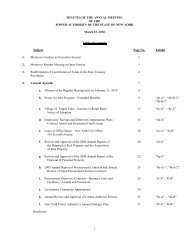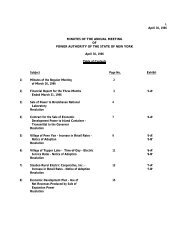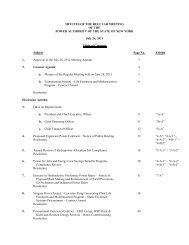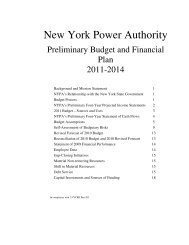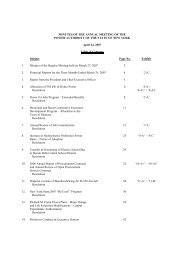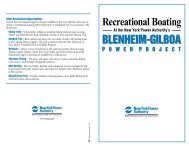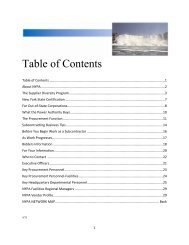July (pdf) - New York Power Authority
July (pdf) - New York Power Authority
July (pdf) - New York Power Authority
You also want an ePaper? Increase the reach of your titles
YUMPU automatically turns print PDFs into web optimized ePapers that Google loves.
casualty and life insurance companies, individual recipients of Social Security and railroad retirement benefits,<br />
individuals otherwise eligible for the earned income tax credit, and taxpayers deemed to have incurred or<br />
continued indebtedness to purchase or carry obligations the interest on which is excluded from gross<br />
income for Federal income tax purposes. Interest on the Tax Exempt Bonds may be taken into account in<br />
determining the tax liability of foreign corporations subject to the branch profits tax imposed by Section 884<br />
of the Code.<br />
Original Issue Discount<br />
“Original issue discount” (“OID”) is the excess of the sum of all amounts payable at the stated<br />
maturity of a Tax Exempt Bond (excluding certain “qualified stated interest” that is unconditionally<br />
payable at least annually at prescribed rates) over the issue price of that maturity. In general, the ‘‘issue price’’<br />
of a maturity means the first price at which a substantial amount of the Tax Exempt Bonds of that maturity<br />
was sold (excluding sales to bond houses, brokers, or similar persons acting in the capacity as underwriters,<br />
placement agents, or wholesalers). In general, the issue price for each maturity of Tax Exempt<br />
Bonds is expected to be the initial public offering price set forth on the cover page of this Official Statement.<br />
Bond Counsel further is of the opinion that, for any Tax Exempt Bonds having OID (a “Discount Bond”),<br />
OID that has accrued and is properly allocable to the owners of the Discount Bonds under Section 1288 of the<br />
Code is excludable from gross income for Federal income tax purposes to the same extent as other interest<br />
on the Tax Exempt Bonds.<br />
In general, under Section 1288 of the Code, OID on a Discount Bond accrues under a constant yield<br />
method, based on periodic compounding of interest over prescribed accrual periods using a compounding<br />
rate determined by reference to the yield on that Discount Bond. An owner’s adjusted basis in a Discount<br />
Bond is increased by accrued OID for purposes of determining gain or loss on sale, exchange, or other<br />
disposition of such Discount Bond. Accrued OID may be taken into account as an increase in the amount of<br />
tax-exempt income received or deemed to have been received for purposes of determining various other<br />
tax consequences of owning a Discount Bond even though there will not be a corresponding cash payment.<br />
Owners of Discount Bonds should consult their own tax advisors with respect to the treatment of<br />
original issue discount for Federal income tax purposes, including various special rules relating thereto, and<br />
the state and local tax consequences of acquiring, holding, and disposing of Discount Bonds.<br />
Bond Premium<br />
In general, if an owner acquires a Tax Exempt Bond for a purchase price (excluding accrued interest) or<br />
otherwise at a tax basis that reflects a premium over the sum of all amounts payable on the Bond after the<br />
acquisition date (excluding certain “qualified stated interest” that is unconditionally payable at least annually<br />
at prescribed rates), that premium constitutes “bond premium” on that Bond (a “Premium Bond”). In<br />
general, under Section 171 of the Code, an owner of a Premium Bond must amortize the bond premium over<br />
the remaining term of the Premium Bond, based on the owner’s yield over the remaining term of the<br />
Premium Bond determined based on constant yield principles (in certain cases involving a Premium Bond<br />
callable prior to its stated maturity date, the amortization period and yield may be required to be determined<br />
on the basis of an earlier call date that results in the lowest yield on such bond). An owner of a Premium Bond<br />
must amortize the bond premium by offsetting the qualified stated interest allocable to each interest accrual<br />
period under the owner’s regular method of accounting against the bond premium allocable to that period. In<br />
the case of a tax-exempt Premium Bond, if the bond premium allocable to an accrual period exceeds the<br />
qualified stated interest allocable to that accrual period, the excess is a nondeductible loss. Under certain<br />
circumstances, the owner of a Premium Bond may realize a taxable gain upon disposition of the Premium<br />
Bond even though it is sold or redeemed for an amount less than or equal to the owner’s original acquisition<br />
cost. Owners of any Premium Bonds should consult their own tax advisors regarding the treatment of bond<br />
premium for Federal income tax purposes, including various special rules relating thereto, and state and<br />
local tax consequences, in connection with the acquisition, ownership, amortization of bond premium on,<br />
sale, exchange, or other disposition of Premium Bonds.<br />
1-10



